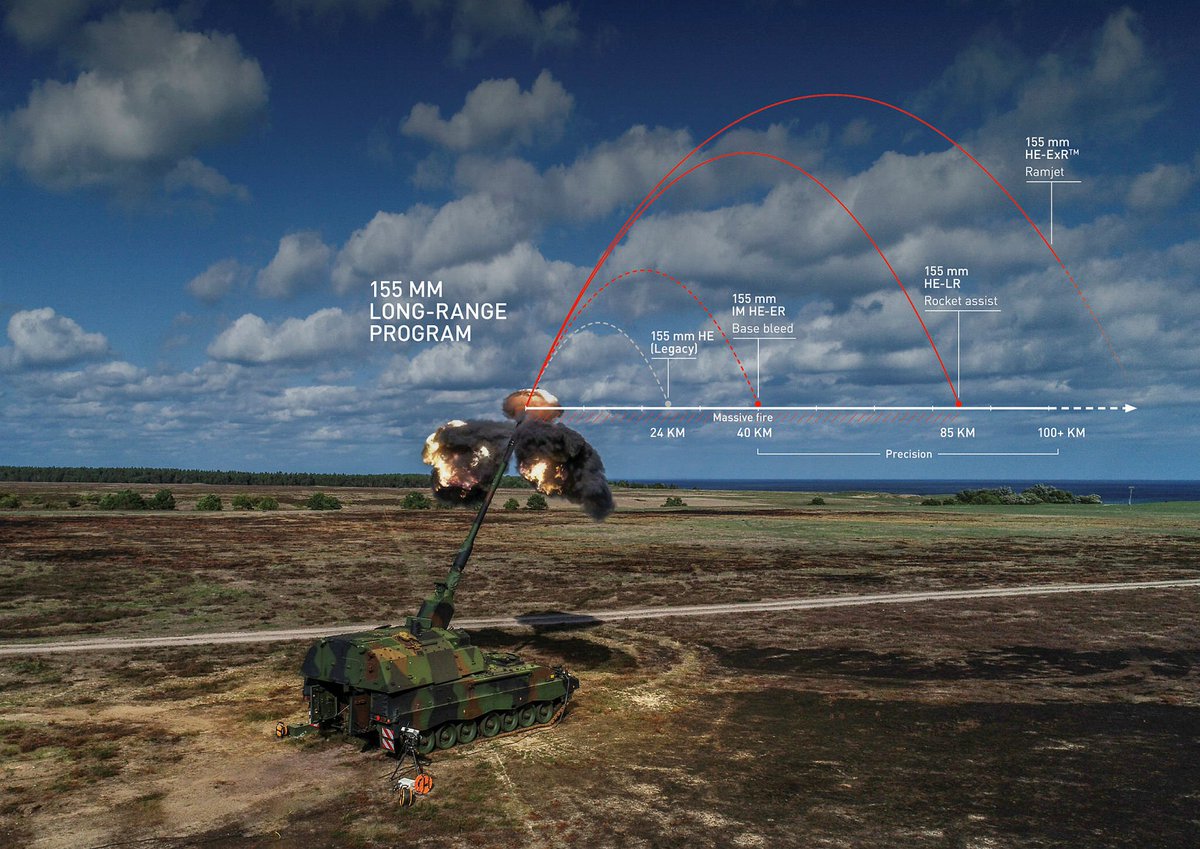Las empresas Raytheon (USA) y TNO (Holanda) desarrollan el nuevo proyectil de artillería de 155mm denominado XM1155. El objetivo es obtener un alcance superior a los 100km, mediante la propulsión adicional del proyectil durante la trayectoria empleando un revolucionario sistema del tipo Ramjet, lo que sumado a un guiado de precisión, le permitiría batir blancos puntuales a distancias inusuales para la artillería convencional.
Raytheon has begun development of the XM1155 Extended-Range Artillery Projectile under an Army contract. The new precision, cannon-launched, ramjet-powered round will extend cannon artillery range to beyond 100 km. XM1155 will be able to strike moving & stationary targets on land and sea.
This is not to be confused with the M1155 Portable Inductive Artillery Fuze Setter (PIAFS), a lightweight, portable, inductive (electronic) fuze-setting device that can work independently or linked to the self-propelled 155mm howitzer M109A5/M109A6 Paladin, towed howitzers, and the Light Weight 155mm Digital Fire Control System (DFCS).
High Explosive Artillery Ammunition are used against personnel, trucks, electronic surveillance and target acquisition devices, supply points, command and control and communications installations, and mechanized and armored forces. HE artillery ammunition is the conventional ammo of choice for war to accomplish fire support and harassment, mining and interdiction, fragmentation and blast effect by U.S. Army, Marines and Air Force.
The the XM1299 is a new 155mm Self Propelled Howitzer (SPH) based on the current M109A7. The 58 caliber cannon increases range from 38km to 70km+. Ammo handling system increases rate of fire from 3 rpm to 10 rpm, with a new cannon and slide block breech design for improved reliability.
The XM1155, a ~100+km ERCA, HE payload provides IAMDS and hard target defeat in GPS-denied environement. Increment 3 also allows introduction of HVP/HGWS FAVADA capabilityinsertion when the capability is mature for Army network and infrastructure insertion.This includes the entire kill chain from Sensor-Shooter-Fire Control-Munition.
The Army Contracting Command – New Jersey (ACC-NJ), on behalf of the Project Management Office – Combat Ammunition Systems (PM CAS) held a two day Industry Day event on 18-19 September 2018. The event provided background information, program plans, and requirements for a 155mm Howitzer, Cannon-Delivered Area Effects Munition (C-DAEM) projectile solutions. The areas of interest for solutions include: integrated projectile designs, airframes, sensors, seekers, fuzing, lethal mechanism, and precision technologies capable of operating in a heavily countermeasured environment. All information presented at the event was free of export control restrictions and were Distribution A. Both days of the event were open to all authorized U.S. and foreign companies. On the second day of the event, PM CAS provided an opportunity for companies to participate in individual sessions.
This Industry Day informed the industrial base of two U.S. Army needs and potential acquisition strategies. The first need is for an extended range 155mm C-DAEM Anti-Armor projectile, maximum range 22km (Threshold), 130km (Objective). This munition must demonstrate lethal capability in challenging operational environments against massed, moving and poorly located, mechanized armored vehicles. Mechanized armor targets include Self-Propelled Howitzers, Main Battle Tanks, Light Tanks, Armored Fighting Vehicles (AFVs), Armored Personnel Carriers (APCs), Air defense artillery, and Multiple Launched Rocket Systems. Engagement of these targets requires the munition to operate in a countermeasured environment, which will include contested GPS and other Electronic Warfare (EW) threats, cyber threats, seeker countermeasures (obscuration etc), and Counter Rocket Artillery and Mortars (CRAM) systems.
The second need is for a C-DAEM projectile that defeats personnel targets and provides lethal effects against mechanized armor. All C-DAEM solutions will require compliance with the existing US DoD Cluster Munition Policy.
The purpose of this market research is to obtain current information on the capability of potential sources to demonstrate, qualify, and produce a C-DAEM Increment 2 projectile for USFY21 – USFY25 military requirements. Multiple awards are anticipated to demonstrate the capability and qualify the design in its intended environments, followed by a contract for production.
The C-DAEM Increment 2 projectile must be capable of defeating personnel, light materiel, and some armored targets in a Global Positioning System (GPS) denied environment from US Army 155mm howitzers (M777A2 or M109A6/7). The C-DAEM Increment 2 must replace 155mm DPICM stockpiles with a cluster munition compliant capability which will broaden the target set, enhance lethality, and extend the reach of the current cannon platforms beyond the current DPICM capability. Responses should be provided given the following assumptions:
- C-DAEM Increment 2 plans a live-fire demonstration of cluster munition policy compliance by Nov 2020. Contractor will deliver 20 projectiles, half of which will be conditioned and fired at cold (-25 degrees F) and half at hot (+125 degrees F). US Government will pay for the testing cost, planned for Yuma Proving Ground, Arizona.
- C-DAEM Increment 2 plans for qualification testing to begin in USFY22 using existing US Army 155mm Cannon Artillery Systems (M109A6/7 or M777A2), fired with the US Modular Artillery Charge System (MACS).
- Production deliveries are planned to begin in the USFY24 – USFY25 timeframe, however incremental strategies to accelerate qualification and deliveries may be proposed.
Fuente: https://www.globalsecurity.org


